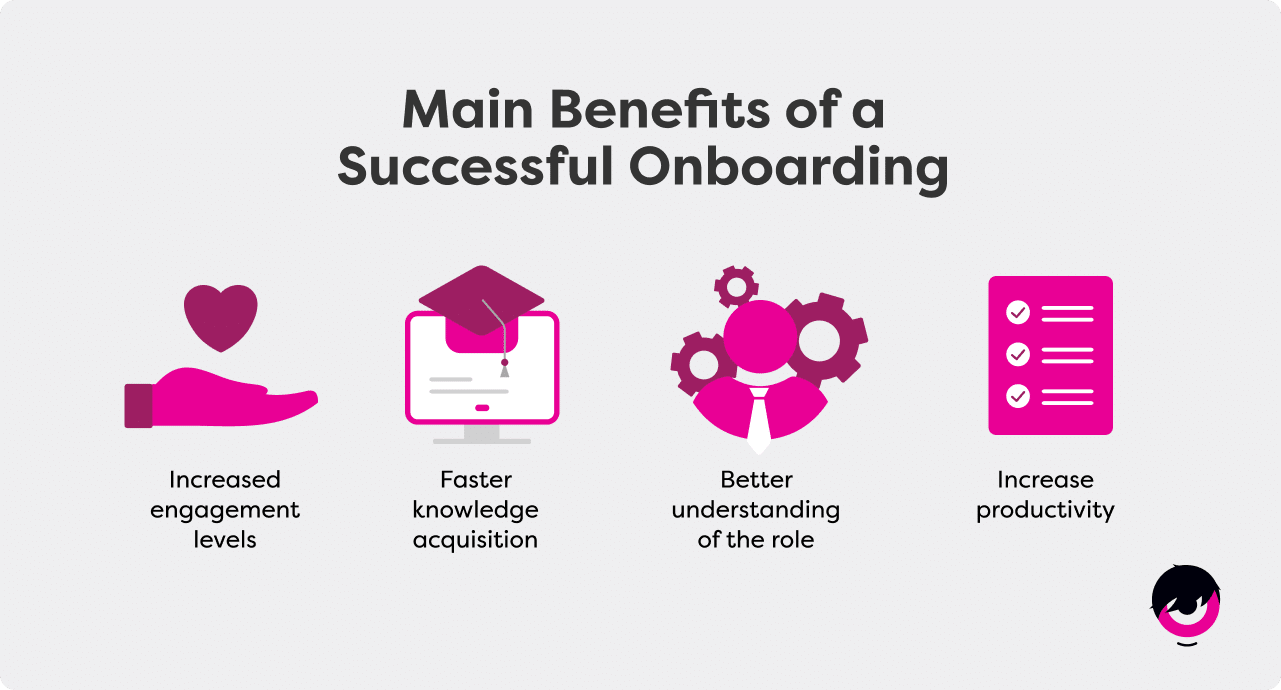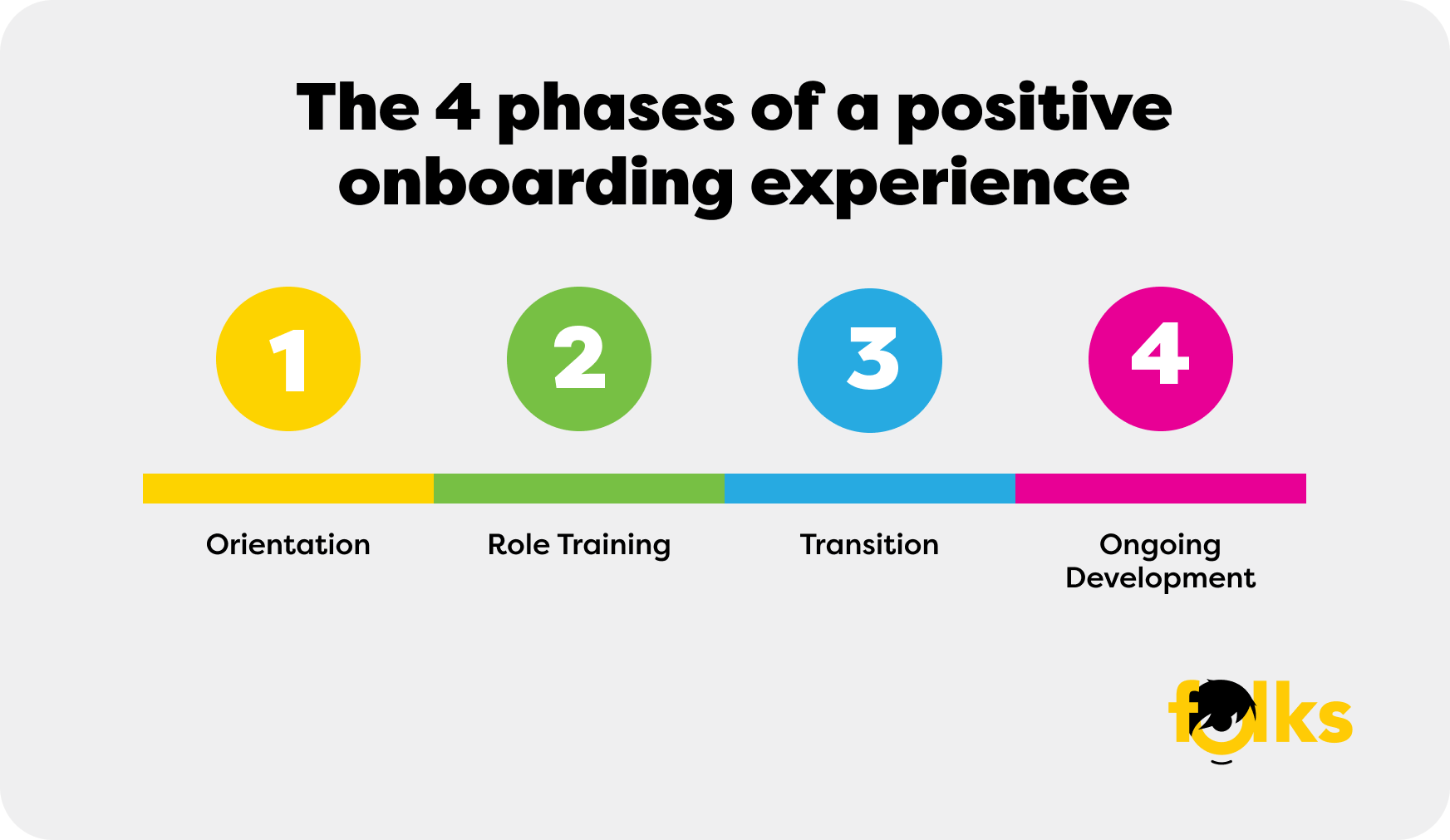Do you know the importance of a well-built employee onboarding process?
Higher employee engagement, quicker knowledge acquisition, less role ambiguity and increased productivity are all benefits that can result from it.
In today’s highly competitive marketplace, an effective onboarding program is also a good strategy for retaining and attracting top talent!
What is an onboarding process?
An onboarding process consists in welcoming, orienting and training a new hire so that they get to know their new work environment, the company’s organizational structure and values, their team members, their new role and their work tools.
In short, the integration process consists of integrating your new arrivals on an organizational level by providing them with the guidance and information they need to achieve their full potential and productivity.
This stage follows the hiring process, and essentially enables the collaborative relationship with your new recruit to begin on a solid, healthy and harmonious footing.
Benefits of a Successful Onboarding
By welcoming new employees in a thoughtful, structured way, companies can reap numerous benefits:
- Increased engagement: the first 45 days of employment account for up to 20% of total turnover. First impressions are important, and it’s essential to succeed in engaging your employees behind a unifying corporate culture right from the onboarding process.
- Faster knowledge acquisition: a new hire who receives adequate orientation and training from the very first days will understand the organization’s structure and mission, their role in reaching objectives, and how to use their skills and work tools to achieve them.
- Better understanding of the new role: with a structured and detailed onboarding plan, you avoid misunderstandings in the distribution of tasks, responsibilities and performance expectations.
- Increased productivity: in addition to improving motivation, an effective onboarding plan has a positive impact on productivity from the very first weeks. A motivated and well-supported employee will give their best as soon as they join the company.

What are the phases of an effective employee onboarding experience?
1. Orientation
The first phase of the onboarding process is orientation. It consists of introducing your newly hired employee to their work environment. This period is critical as it marks your new hire’s first days in your organization and, in doing so, the beginning of your employee-employer relationship.
When a new employee joins your team, they are likely to have questions regarding their role, the company itself, your organization’s standard practices, and your corporate culture.
Our advice: avoid overwhelming the newcomer as soon as they walk through the door and try making a smooth integration. After all, no one wants to feel rushed as soon as they start a new job.
Instead, use this time to introduce your new hire to your team members, build trust and answer their questions. Be flexible and adapt to the person in front of you!

2. Role Training
The next step is the training of your employee. This is the time when your new hire learns the ropes of the job. This period is an important part of a good onboarding process as it is closely linked to long-term employee productivity.
To ensure that this period goes smoothly, you will want to establish a training plan. This will allow you to properly identify the skills needed and target the priorities: an exercise that will significantly simplify the implementation of this phase.
We also recommend that you identify the resource person(s) responsible for the various components of the learning process. By properly supervising your new employee, you maximize their chances of succeeding in their training!
Our advice: be organized and attentive! Some people may ask more questions, while others may be more self-taught when it comes to learning. Try to tailor the training to your employee’s profile.
3. Transition
Now it’s time to prepare your recruit for the transition phase. At this stage of the onboarding process, your employee moves into their permanent role. The most important part of the transition phase is defining your new hire’s tasks and how those tasks will fit into the business’s overall goals.
Aligning expectations is critical. Therefore, you’ll want to remind your managers to schedule periodic evaluations. Regular follow-ups will help ensure that goals are being met, that improvement strategies are in place if necessary, and that the new hire is comfortable, happy and committed to the job. That way, when the time comes, the probationary evaluation won’t be a surprise to anyone.
The transition phase is also the right time to implement a culture of recognition. Recognizing the individual, the results, the effort, and the work practices can play an essential role in overall employee satisfaction and retention.
Incorporating tools like Python for data analysis in evaluating employee performance metrics can further streamline this phase, providing precise insights into areas of achievement and needed improvement.
Our advice: stay available! Learning a new job takes time. It is, therefore, essential that your employee feels comfortable coming to you with questions when they encounter a difficulty. Keep your door open and listen to your employee: communication will always be your best ally!

4. Ongoing Development
Now that your employee is well integrated, the final stage is ongoing staff training. This last phase significantly affects employees’ sense of belonging, overall performance, and retention.
Businesses that offer career advancement and development opportunities find that their employees are more satisfied and more likely to evolve within their company: an outstanding asset in the current context of labour shortages. Offering continuous training is an effective way to improve your employer’s brand and stand out in the job market.
Our advice: take advantage of the tools available to help you simplify training management!
These include LMS (Learning Management Systems) that allow you to easily develop and manage training materials. Such platforms will enable you to create customized training programs to support the professional development of your workforce.
As for HRIS (Human Resources Information Systems), they can help you manage the follow-up of the training plan and the financial side of it more efficiently. Each employee’s training course will be listed in a single interface, and your HR team will have real-time access to their progress.

The 4 phases of a successful onboarding process are part of a solid and personalized onboarding plan and have multiple benefits for your business. They allow you to mobilize your workforce, promote your employer brand, encourage open communication within your organization and significantly increase your retention rate.
However, this process can be somewhat hazardous to implement without an onboarding software. To avoid manual management and the inconveniences that can result from it, there is only one solution: automating your employee onboarding process!
Don’t forget to download our free employee onboarding checklist for a successful onboarding.
Want to discover the benefits of automating your onboarding process?
Folks HR offers complete onboarding features!
